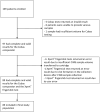Independent assessment of a point of care HCV RNA test by laboratory analytical testing and a prospective field study in the U.S
- PMID: 40694587
- PMCID: PMC12282913
- DOI: 10.1371/journal.pone.0324088
Independent assessment of a point of care HCV RNA test by laboratory analytical testing and a prospective field study in the U.S
Abstract
Improvements in HCV testing, including Point of Care (POC) HCV RNA tests, are necessary to eliminate HCV. With this goal in mind, we established methods to collect capillary whole blood (CWB) via fingerstick, ensured its stability in a microtainer, and determined limit of detection (LoD) for various HCV genotypes. Next, we conducted a prospective study where CWB samples were collected from a cohort of 109 adult subjects at a safety-net hospital and tested for HCV RNA using the Xpert® HCV test on the GeneXpert® Xpress system and the cobas® HCV platform. We consistently obtained 250 μl CWB which was stable for up to 5 hours in the microtainer. Laboratory LoD studies demonstrated that the Xpert® HCV test could detect most HCV genotypes to <100 IU/ml in CWB. In the prospective clinical study, 89 subjects (82%) with valid Xpert® and cobas® HCV comparator results were analyzed. Using Xpert®, 16 out of 89 (18%) subjects had detectable HCV RNA and 73 (82%) had undetectable HCV RNA. Using cobas, 17 out of 89 (19%) participants had detectable HCV RNA, and 72 (81%) were undetectable. One sample was detectable on cobas but not Xpert®, yielding a sensitivity of 94% and specificity of 100%. This study demonstrates the feasibility of HCV RNA testing at POC using CWB obtained by fingerstick and provides preliminary data on the accuracy of the Xpert® HCV test performed by untrained operators in a CLIA-waived setting.
Copyright: © 2025 Miller et al. This is an open access article distributed under the terms of the Creative Commons Attribution License, which permits unrestricted use, distribution, and reproduction in any medium, provided the original author and source are credited.
Conflict of interest statement
Lesley Miller reports grant funding from Gilead Sciences and consulting fees from AbbVie. Shelly-Ann Fluker reports consulting fees from Roche. The other authors declare that they have no conflicts of interest.
Figures

Similar articles
-
Point-of-care viral load tests to detect high HIV viral load in people living with HIV/AIDS attending health facilities.Cochrane Database Syst Rev. 2022 Mar 10;3(3):CD013208. doi: 10.1002/14651858.CD013208.pub2. Cochrane Database Syst Rev. 2022. PMID: 35266555 Free PMC article.
-
NIH Consensus Statement on Management of Hepatitis C: 2002.NIH Consens State Sci Statements. 2002 Jun 10-12;19(3):1-46. NIH Consens State Sci Statements. 2002. PMID: 14768714
-
Signs and symptoms to determine if a patient presenting in primary care or hospital outpatient settings has COVID-19.Cochrane Database Syst Rev. 2022 May 20;5(5):CD013665. doi: 10.1002/14651858.CD013665.pub3. Cochrane Database Syst Rev. 2022. PMID: 35593186 Free PMC article.
-
Diagnostic accuracy of detection and quantification of HBV-DNA and HCV-RNA using dried blood spot (DBS) samples - a systematic review and meta-analysis.BMC Infect Dis. 2017 Nov 1;17(Suppl 1):693. doi: 10.1186/s12879-017-2776-z. BMC Infect Dis. 2017. PMID: 29143616 Free PMC article.
-
Point-of-care tests detecting HIV nucleic acids for diagnosis of HIV-1 or HIV-2 infection in infants and children aged 18 months or less.Cochrane Database Syst Rev. 2021 Aug 12;8(8):CD013207. doi: 10.1002/14651858.CD013207.pub2. Cochrane Database Syst Rev. 2021. PMID: 34383961 Free PMC article.
References
-
- Hepatitis C | Viral Hepatitis Surveillance Report. Available from: https://www.cdc.gov/hepatitis/statistics/2021surveillance/hepatitis-c.htm. 2021.
-
- New estimates reveal declines in hepatitis C treatment in the U.S. between 2015 and 2020. Available from: https://www.cdc.gov/nchhstp/newsroom/2021/2014-2020-hepatitis-c-treatmen.... 2021.
-
- Fleurence RL, Collins FS. A national hepatitis C elimination program in the United States: a historic opportunity. JAMA. 2023;329(15):1251–2. - PubMed
MeSH terms
Substances
LinkOut - more resources
Full Text Sources
Medical

